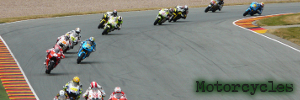















What Makes Harleys So Special? |
|---|

 Topics: Harley-Davidson
Topics: Harley-Davidson
|
Ted Landphair
Voice of America
August 1, 2001
Audio Version of "What Makes Harleys So Special?" 777KB RealPlayer
In the Midwest farm state of Wisconsin, you'll find thousands and thousands of hogs. Not just four-legged porkers, but also steel and chrome motorcycles that riders affectionately call "hogs." They are Harleys - the only motorcycles still mass-produced in the United States. Wisconsin's largest city, Milwaukee, is home to the Harley-Davidson Motor Company and an entire Harley culture.
Freedom. Adventure. Pavement. Leather. Chrome. These are some of the words that spring to the screen when you open the Harley-Davidson Motor Company's web page on the Internet. The company boldly asserts - and most owners agree, that a Harley is more than a machine that goes fast. It's a way of life.
And Harleys are a breed apart from other motorcycles, thanks to their powerful, boisterous engines; to their rebel image dating to Marlon Brando's portrayal of a motorcycle gangster in the 1954 film "The Wild One"; and to the annual gathering of thousands of Harley owners in the little South Dakota town of Sturgis.
Randy Martin looks nothing like the image that some people have of bikers as bearded, tattooed Hells Angels gang members. A 52-year-old, clean-shaven, conservatively dressed brewery employee, Mr. Martin just traded in his '96 hog for a new, solid-black Harley with lots of chrome. "Once you get the bike, you have to get all the motor clothes that go with it," he says. "And it's fun, 'cause there's always new things comin' out. It's like your own personal trademark that says something about your personality."
"So what does it say about you?" asks VOA's Ted Landphair.
"I want to look macho on the bike," responds Mr. Martin. "I want to blend in with the rest of the bikers. And I enjoy the total experience."
As he looks around Hal's Harley dealership in New Berlin, Wisconsin, Mr. Martin has his pick of jackets, gloves, T-shirts, jewelry, golf balls, knives, stuffed animals, picture frames, beer steins even fish hooks all imprinted with the famous orange, black, and white Harley-Davidson logo. You can even buy Harley-Davidson coffee.
Kirk Topel, Hal's general manager, has raced Harleys since he was 16. His office looks down on six rows of new Harleys, the largest of which costs $25,000 and comes with a wraparound fiberglass windshield, cruise control acceleration, and a communications system that connects driver and passenger. It weighs more than 350 kilos. "There are very few modes of transportation where you become a part of the country that you travel through - the freedom of just being able to turn a wrist and accelerate, with the wind in your hair, and the breeze in your face, and feeling the warmth of the sun on your skin," he says.
Harleys and horses. Harley-Davidson's company historian, Martin Jack Rosenblum says it's an interesting pairing, going back to the company's founding in 1903. "Think about the era," he says." [Western frontier marshal] Wyatt Earp was still alive. He died in 1929. It was still the spirit of the Old West. The archetypal cowboy on horse, these were still around. And I believe that there was a transfer from horse to motorcycle [in the nation's imagination]."
Martin Jack Rosenblum oversees the company collection of thousands of artifacts including Harley's first production cycle, built by William T. Harley and three Davidson Brothers. Mr. Rosenblum says Harleys have been called "hogs" since the 1920s, when a rider carried the Harley racing team's pet pig astride his gas tank on victory laps. Historian Rosenblum is also a poet and admitted romantic who says one lure of a Harley is rebelliousness the desire to be unique. "It's a shamanistic sensibility that when you get this motorcycle, it transforms you," explains Mr. Rosenblum." You transform it. Each rider personalizes his or her motorcycle to such an extent that it really becomes a folk art rolling sculpture. Whoever you dream yourself to be, you will make your bike into. Your are saying, 'Leave me alone. I'm just doing what I want to do.' "
Visitors can tour Harley's production facility in Milwaukee and watch engines being tested. Each day, one is randomly yanked off the assembly line and placed on a machine called a "dyno" that performs several tests over 10 hours. Then the engine is completely disassembled to check for wear.
Tour guide Michelle Fox says each person on the assembly line has exactly three minutes, 17 seconds to perform a function before the line moves. "Operators will know how much time they have by the warning bells that sound off," she explains. "There's also a red button there that they can press in case of emergency that they can shut down this whole entire line ." The Harley-Davidson Motor Company does not just build new Harleys. It also still makes parts to fit cycles going as far back as a kick-start pedal for a 1916 Harley. Some of the company's 6,000 workers worldwide take old cycles and perform what is called "remanufacturing" installing new parts, sprucing up the finish, and adding accents like custom pinstriping. Each Harley tells a story, and each owner tells hundreds of them.
